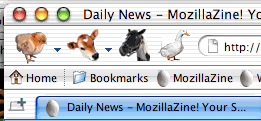I made a one line code addition and built Phoenix with metal windows. Check here for a screenshot. The bad news is that the metal windows flicker like hell when the contents are updated or resized. Also some of the chrome elements tend to vanish and reappear. Pretty, but totally unusable.
Author: Kevin
Mac Phoenix Update
Since January there has been over 12,000 downloads of the Mac build of Phoenix. Thanks everyone for your interest and feedback.
Update April 5: I’ve just posted a new build of Phoenix. Check it out and let me know if you have questions or comments.
New Mozilla Theme!
Announcing a Very Special Mozilla Theme! This theme is based on Pinstripe and follows the Aqua Human Interface Guidelines to the letter:
“In order to make toolbar icons easily distinguishable from one another, each icon should be a distinct animal. Use real-world objects (such as a moose) to facilitate quick recognition by users.”

New Music: Mambo Sinuendo
Mambo Sinuendo by Ry Cooder and Manuel Galbán: This is the kind of album that I often look for when selecting music to fit the mood I’m in. The groovin’, swingin’ and sometimes muted tunes don’t demand your full attention – they can float by themselves in the background. Click the link above and listen to some samples.
Pinstripe Theme and Mozilla 1.3
Pinstripe will not install on Mozilla 1.3 final. From the Mozilla 1.3 release notes: “On Mac OS X, XPInstall has been disabled for 1.3. This means that extensions and themes will not install for Mozilla 1.3 on Mac OS X. (bug 196959)”.
Update (April 22, 2003): Mozilla 1.3.1 builds have been released which fixes the software installation mechanism on OS X!
Replacement Icons for the Pinstripe Theme
I’m considering replacing the current Pinstripe icons with the ones below. Take a look and leave a comment with your thoughts [popup window].
Continue reading “Replacement Icons for the Pinstripe Theme”
Pinstripe Theme Updated
I’ve made some minor tweaks to the Pinstripe Theme to bring it up to date with Mozilla 1.3. If you have any questions you can leave a comment below or send me an email.
The Meaning of Life
I’ve come to the conclusion that I have no life. Thankfully I have access to a large selection of products designed to solve this complex problem. Most of these solutions are “digital” in nature.
Apple Computer’s iLife suite of products helps me effortlessly manage my “digital lifestyle”. AT&T’s mLife let’s me be mobile on my own terms. Their advertisement tells me that “we are meant to lead a truly wireless life“. They promise me “more minutes than ever before”. I’m not quite sure what that means but it sure sounds exciting! Sign me up!
Of course these products would be meaningless without a support system to guide my transition to digital Nirvana. Luckily my good friends at T-Mobile prompt me to “get more out of life”. And thanks to interventions by the kind folks at Verizon Wireless, I’m making progress every day.
Redesigning the Button of Doom
Slashdot has a link to an interesting article about an effort to design a smarter “temporal” Back button for browsers. This paper describes the experiment in detail, complete with pictures of a prototype “enhanced” Back button. According to the paper’s conclusion, the reimagined button is not less confusing than current implementations and it doesn’t necessarily make users more efficient. While the idea of helping users navigate web page history easily is definately worthy of consideration, web authors should be building their sites so users don’t need to use the Back button in the first place.
I'm a moron
I’ve been building a new computer over the past few days. I had read Asa Dotzler’s experiences with Red Hat Linux 8.0 and I was looking forward to trying it out myself.
After a little over a year using Mac OS X, my life has been relatively free of compiling drivers and kernels and dependency hell. And wow! The Red Hat install went very quickly and seemed to detect all of my hardware.
The Redhat desktop came up and I tried to play a wav file. Silence. I tried bringing up the Volume app and I saw an error message that complained about a problem with the sound driver. I opened the Sound preferences and it listed my sound card with the correct kernel module loaded, but I heard nothing when I tried to play the sample sound.
So a Google search lead me to a few discussions that suggested the drivers from the ALSA Project. Ah! This is the Linux I remember. Configure. Make. Make install. After about 15 minutes I had the ALSA drivers installed, but still no sound. But there were no error messages in /var/log/messages and the volume app worked.
After 20 minutes of combing message boards, checking my modules.conf file, and more dithering, I looked at the back of the machine and noticed that I hadn’t plugged the speakers into the sound card. Oops!